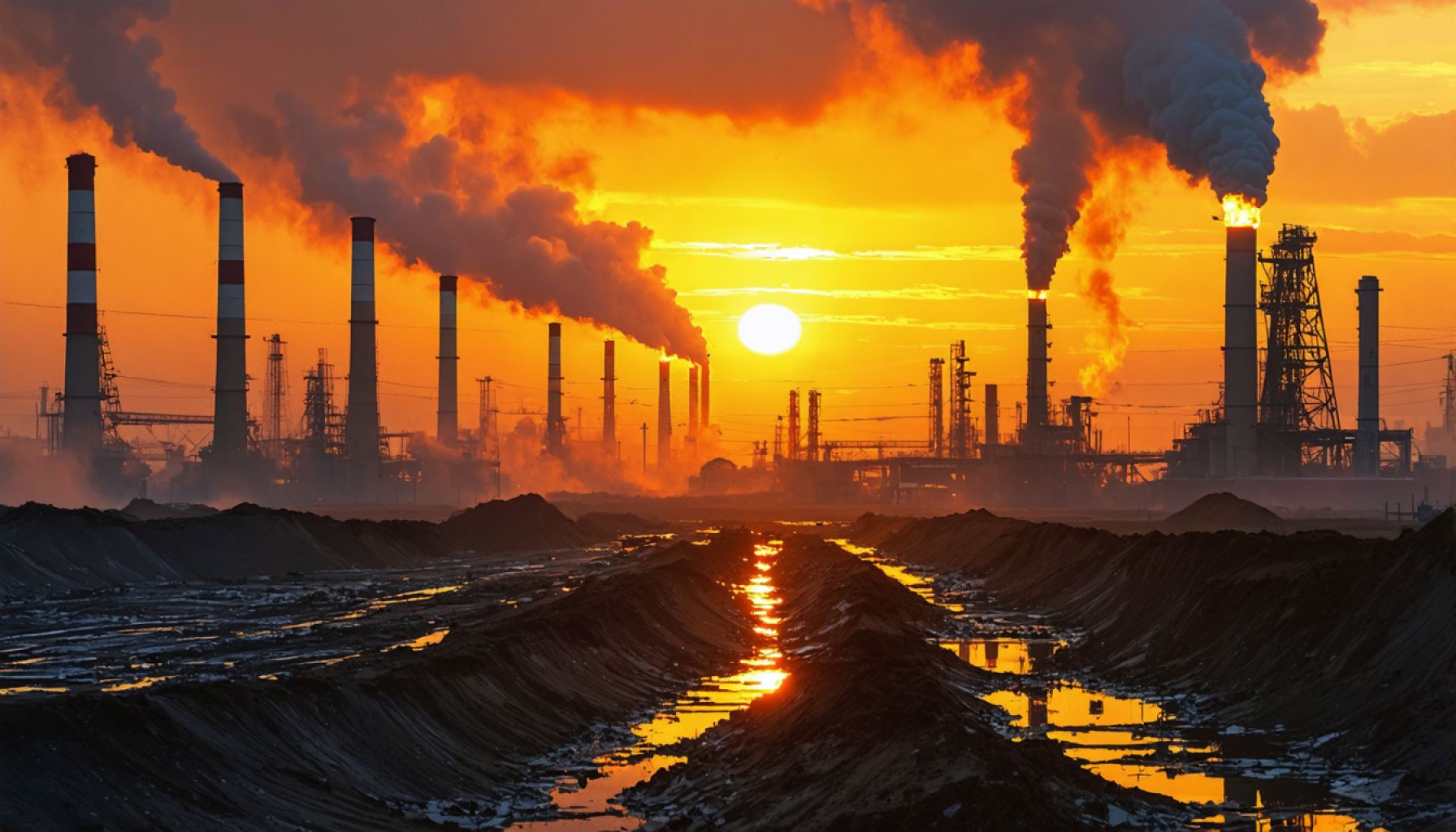- The dominance of the fossil fuel industry is declining, with oil and gas seen as increasingly risky investments.
- In 2024, fossil fuel stocks grew by just 5.72%, compared to the broader market’s 23% increase.
- Tariffs on Canadian steel and aluminum in 2025 will raise costs for oilfield operations, impacting smaller companies like Solaris Energy Infrastructure (SEI).
- SEI’s stock dropped over 32% in March, failing to meet market expectations despite a revenue increase.
- Renewable energy is attracting investors with its stable returns, contrasting the volatility of fossil fuels.
- The clean energy sector is contributing to job market growth and providing long-term career opportunities.
- This transition is aligning financial goals with environmental sustainability, emphasizing the importance of staying informed during the shift to a greener future.
The landscape of energy investment is undergoing a seismic shift, as the fossil fuel industry finds its dominance waning. Once the bedrock of the global economy, oil and gas are increasingly being recognized as risky ventures. In recent years, the stocks of companies like Solaris Energy Infrastructure, Inc. have staggered, revealing troubling signs for an industry grappling with the stark realities of a world pivoting to sustainability.
Imagine an era when fossil fuels symbolized economic prosperity. That era, it seems, is slipping away. In 2024, fossil fuel stocks yielded meager returns of 5.72%, dwarfed by the broader market’s robust 23% growth. By 2025, the plot thickens with the U.S. doubling tariffs on Canadian steel and aluminum, crucial to oilfield operations. These tariffs inflate costs, particularly for smaller entities like SEI, which depend heavily on the spot market for supplies.
Between March 3 and March 10, SEI’s stock plummeted over 32%, a jarring downturn following February’s optimistic surge. Despite posting a 28% uptick in revenue during the last quarter of 2024, SEI’s earnings failed to meet market expectations. The story of SEI is not isolated but rather a reflection of a broader struggle faced by fossil fuel entities.
As fossil fuels fumble, a hopeful beacon shines. Renewable energy surges forth with the promise of more dependable returns, luring investors who have grown weary of the volatile fossil fuel sector. Cleaner energy sources deliver predictability that stands in stark contrast to the cyclical nature of oil and gas.
Connor Chung, a respected energy finance analyst at the Institute for Energy Economics and Financial Analysis, succinctly notes that the fossil fuel industry has not yet adapted to the reality of an increasingly decarbonizing world. The traditional business model now finds itself at odds with global trends that favor sustainability.
However, this transformation transcends investment strategies; it’s revolutionizing the job market. As capital flows into renewables and grid enhancements, new career pathways unfurl. Unlike fossil fuels, which oscillate with global commodities, the clean energy industry promises stability and long-term growth — an enticing proposition for both seasoned investors and fresh graduates.
While some environmental, social, and governance (ESG) strategies have wavered, the ascent of renewable energy remains unyielding. The waning allure of fossil fuels underscores a pivotal transition that is no longer an approaching phenomenon; it is actively reshaping our reality.
Navigating this remarkable energy metamorphosis presents opportunities to align financial goals with the planet’s welfare. For those eager to partake in this transformative era, staying informed remains crucial as we collectively stride towards a cleaner, greener future.
The Energy Landscape Revolution: Key Insights and Future Directions
Transforming Energy Investments: A Deep Dive
The shift from fossil fuels to renewable energy sources isn’t just a trend; it’s a seismic shift reshaping global economic foundations. As the fossil fuel industry grapples with declining dominance, stakeholders are witnessing the dawn of an era where renewables promise robust returns and sustainable growth. Below, we explore additional insights into this ongoing transformation, providing expert-backed predictions and actionable recommendations.
Insights & Predictions: The Renewables Resurgence
1. Market Forecasts & Industry Trends: The renewable energy market is projected to grow substantially through 2030. According to the International Energy Agency, renewable electricity capacity could expand by 60% during this decade, driven by solar and wind energy, which offer scalability and cost efficiencies.
2. Features, Specs & Pricing: Solar power costs have plummeted by over 80% in the past decade due to technological advancements and economies of scale. Similarly, wind energy prices have fallen, making these sources increasingly competitive against traditional fossil fuels.
3. Real-World Use Cases: Countries like Germany and Denmark are leading the renewable charge, generating a significant portion of their electricity from wind and solar sources. These nations serve as blueprints for integrating renewables into national grids, highlighting the potential for energy independence.
How-To Steps & Life Hacks for Investors
1. Understand the Market Dynamics: Investors should familiarize themselves with the renewable sector’s nuances — from policy impacts to market demands. This knowledge provides a competitive edge when navigating volatile transitions.
2. Diversify Your Portfolio: Consider spreading investments across various renewable technologies to mitigate risks. Diversification can involve direct investment in renewable companies or funds specializing in sustainable energy.
3. Stay Informed: Regularly follow trusted energy analysis portals like International Energy Agency and International Renewable Energy Agency, providing updates on global energy trends and innovations.
Controversies & Limitations: The Pragmatic Perspective
1. Intermittency Issues: Renewables face challenges such as intermittent supply — solar and wind power depend on weather conditions. Battery storage solutions are being developed to counteract this, with technological advancements expected to improve grid stability.
2. Environmental Concerns: The production and disposal of solar panels and batteries raise environmental questions. Ongoing research aims to develop more sustainable materials and recycling processes.
Security & Sustainability: Moving Towards a Greener Future
– Grid Modernization: Enhancing grid infrastructure to handle renewable sources is crucial. Smart grid technologies can improve energy efficiency and manage supply-demand fluctuations effectively.
– Sustainability Practices: As renewables become more mainstream, ensuring responsible resource management during production is essential to preserve ecosystems and local communities.
Pros & Cons Overview
Pros:
– Long-term savings and reliability
– Reduced carbon footprint, aligning with global climate goals
– Lower volatility compared to fossil fuels
Cons:
– Initial high investment costs
– Technological and infrastructural challenges
– Dependent on policy and regulatory frameworks
Actionable Recommendations
– Immediate Steps for Investors: Shift part of your investments to ETFs that focus on renewable energy. Platforms like Vanguard offer ESG funds that align with sustainable investment strategies.
– Stay Engaged: Attend energy sector webinars and conferences to interact with industry experts and stay updated on breakthroughs and policy changes.
In conclusion, the decline of fossil fuels signals a pivotal reorientation towards sustainable investments. By staying informed and proactive, investors and professionals alike can capitalize on the opportunities presented by the rise of renewables and contribute to a more sustainable future.











